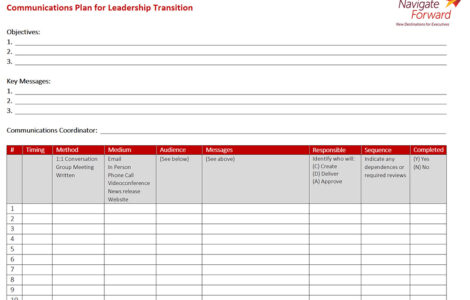
When it comes to professional networking, executive recruiters have seen it all. Long and rambling meetings. Urgent requests for next-day appointments. Non-stop talkers focused solely on themselves.
It’s no surprise that Marcia Ballinger, cofounder of the non-profit search firm Ballinger | Leafblad, has made it her personal mission to stamp out poor networking practices. She’s the author of The 20-Minute Networking Meeting, Winning the Executive Interview, and Make the Jump: Reinvent Your Career in the Nonprofit Sector. She’s also a frequent guest speaker at Navigate Forward.
We adapted her recent client presentation to help executives avoid these common professional networking mistakes.
Mistake #1: Undervaluing Networking
Think you can move your career forward without activating your network? Ballinger sees otherwise (and so do we at Navigate Forward!). More than 80 percent of senior leaders will find their next position through professional networking.
It’s the single most important avenue for those looking for full-time work, seeking corporate board seats or pivoting to consulting, fractional work or non-profit roles. The more you engage in quality networking, the greater your odds of success at realizing your career goals.
More than 80 percent of senior leaders will find their next position through professional networking
Mistake #2: Making the Wrong Ask
Whether it’s a face-to-face or a virtual networking meeting, it’s vital to make it easy for your target contact to say “yes.” Yet too many executives use a generic approach that can fall flat.
Ballinger urges networkers to do some homework and increase the “connectedness” in your invites. Referred by a mutual connection? Call it out in your email subject line. Share a favorite non-profit cause or graduate from the same college? Mention it in your request. LinkedIn and company bios are good tools to find this common ground.
Most importantly, show you value your audience’s time and schedule. Offer to come to their workplace or favorite coffee shop, or use their preferred virtual technology, at a time and date that’s convenient for them.
Mistake #3: Running Long
A 60- or 90-minute discussion may seem impressive, but to Ballinger, it signals a lack of respect. She advocates for a provocatively short interaction: just 20 minutes. It’s a power-packed session that lets you establish a relationship with a new connection and ask a few information-seeking questions.
Opt for short, power-packed sessions, then use your time wisely
Keeping it short means being prepared and managing your time wisely. Above all, be aware of what a networking meeting is not meant to be. It’s not a job interview, a time to read the bullet points on your resume, or to ask for a job outright. For Ballinger, it is a stop on your “wisdom-seeking tour.” Use your limited time to make a strong first impression.
Mistake #4: Talking Too Much

Oversharing is one of the most common networking mistakes. It’s natural, notes Ballinger, as many professionals are anxious about how to fill the time with a new acquaintance. Yet the best networking sessions are spent listening and learning rather than holding the floor.
She advises limiting your commentary to the short professional narrative that sets the stage for the conversation. Then, let your audience shine. Most executives are honored to share their insights and experience. Add to the conversation as needed, but leave out the step-by-step of your career journey unless specifically asked.
Mistake #5: Winging It
Showing up unprepared is another quick way to sink your opportunity. No one wants to set aside time to repeat information that’s readily available online, or to struggle with inquiries outside their area of expertise.
It’s essential to check out your contact’s LinkedIn profile, company website and any thought leadership they’ve authored before you meet, so you’re familiar with their perspectives. Then, develop a handful of questions that are relevant to your career goals and your contact’s sphere of influence.
The best networking sessions are spent listening and learning rather than holding the floor
Ballinger cautions against general questions, such as, “How’s the job market right now?” or “What trends are you seeing in the economy?” After all, everyone’s industry, professional experience and target next role will make those answers subjective.
Mistake #6: Neglecting Your Online Brand

These days, a LinkedIn or Google search on your name is a given when you’re asking for a networking meeting. Make sure your presence creates a positive first impression.
First, compare your resume, networking brief and LinkedIn profile side-by-side. Is there commonality? Are dates accurate? Are both thorough and relevant? Then, review your social media. Your online connections, your profile description and your activity level on LinkedIn, Facebook, X (Twitter) and other platforms all create a public picture of you that should be authentic, engaging and consistent.
Make Helping Others a Mutual Event
With the right mindset and preparation, professional networking can yield tremendous results, from establishing productive relationships and learning new things to uncovering opportunities. As Ballinger notes, we’re all just a few dozen coffee meetings away from reaching our goals.
Ballinger suggests closing with a simple question: How can I help you?
Bringing a spirit of helpfulness and gratitude to your engagements is key, especially for those who dislike asking for help. Ballinger suggests closing every networking conversation with a simple question: How can I help you?
With this approach, you’ll be able to add value and feel great. Even if you’re in career transition, you can provide referrals to other connections, share your own area of expertise or simply be available for future requests.
Get more networking guidance. All current Navigate Forward clients and alumni can attend our virtual Executive Forums where we feature exceptional speakers and guidance on professional networking, winning LinkedIn profiles, and other topics tailored to senior leaders. View our program calendar and sign up by logging into the Client Portal.
About Marcia Ballinger
Marcia Ballinger has been a leader in the Twin Cities executive search community for nearly two decades. Over the years, she has developed a specialty in non-profit recruiting, most often working with boards of directors and search committees, assisting them as they make important and often challenging decisions. She is co-founder and partner in the executive search firm Ballinger | Leafblad.
Marcia got into executive search after a career in human resources development with technology companies, beginning with IBM. She is a frequent speaker on the topics of executive networking, career management and best practices in executive recruiting.



